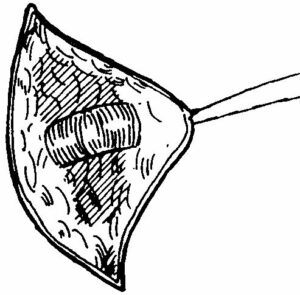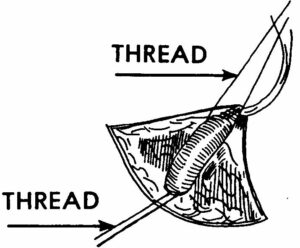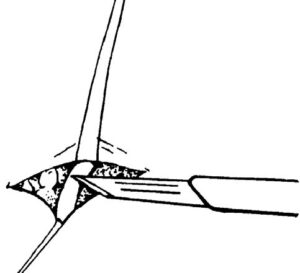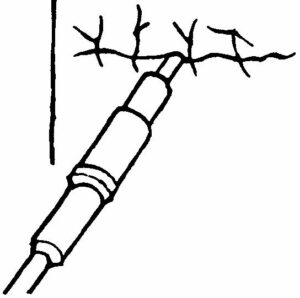3-27. INTRODUCTION
The venous cutdown is a minor surgical procedure normally done by a physician. The following information is presented for the medical NCO so that you will be acquainted with the method. You may be called upon to assist the physician in maintaining sterility of the equipment and in caring for the patient following the procedure. Venous cutdown is a sterile procedure.
3-28. REASONS FOR USING THE VENOUS CUTDOWN
If an external site for the venipuncture cannot be located, a venous cutdown can be required. This situation may occur when a patient’s veins have collapsed. If the patient is in shock, very thin, or in poor physical condition, a site for venipuncture may not appear. By doing a venous cutdown, the catheter can be inserted directly into a vein, and intravenous therapy can be started.
3-29. VENOUS CUTDOWN PROCEDURE
The following is a brief discussion of the venous cutdown procedure. You will perform only those actions that the physician tells you to perform.
a. Equipment and Supplies. Equipment and supplies used in a venous cutdown are listed below.
(1) Sterile gloves.
(2) Scalpel handle and blades.
(3) Suture materials.
(4) Hemostats.
(5) Scissors (vascular and suture).
(6) Supplies for prepping and dressing the wound area.
(7) Intravenous setup.
(8) Sterile towels, mask.
(9) Splint, if required.
(10) Other supplies and equipment as required by physician (and available).
b. Site. Several sites may be chosen depending on the condition of the patient and the fluid to be infused. Some suggested sites are listed below.
(1) Basilic vein above the elbow.
(2) Basilic vein below the elbow.
(3) Saphenous vein above the ankle.
(4) Cephalic vein below the elbow.
c. Procedure for the Cutdown.
(1) Assemble the equipment and supplies.
(2) Wash your hands.
(3) Explain the procedure to the patient.
(4) Prepare and stabilize the site.
(5) Apply/inject a local anesthetic so the patient will not feel the incision.
(6) Make a transverse cut and dissect the tissue until the vein is visible (see figure 3-7). Using a curved hemostat, gently spread the underlying tissue to fully expose the vein.

(7) Lift the vein and put two threads of suture under it (see figure 3-8).

(8) Tie both threads and pull in opposite directions. Leave enough vein between the two ties to insert the catheter.
(9) Nick the vein with a scalpel (or cut with vascular scissors). (See figure 3-9.)

(10) Insert the proper size plastic catheter into the exposed vein (to near the catheter hub) and secure (see figure 3-10).

(11) Attach catheter to previously prepared infusion set and close the wound.
(12) Suture the incision and apply an antibiotic ointment (see figure 3-11).

(13) Apply a sterile dressing and tape the catheter in place.
(14) The procedure must be documented (usually in Nursing Notes). Physician will specify when to remove the skin sutures.
(15) Outer tape should show catheter size, date and time of insertion, and inserter’s initials.
